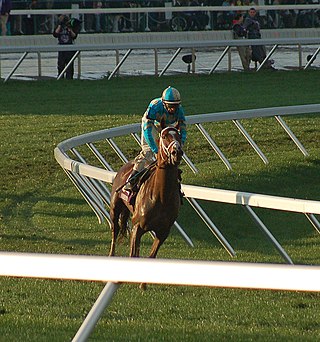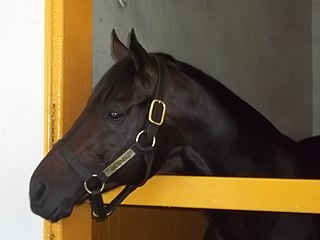Related Research Articles

Keeneland Association, Inc. is an equine business based in Lexington, Kentucky. It includes two distinct divisions: the Keeneland Race Course, a Thoroughbred racing facility, and Keeneland Sales, a horse auction complex. It is also known for its reference library.

The Breeders' Cup World Championships is an annual series of Grade I Thoroughbred horse races, operated by Breeders' Cup Limited, a company formed in 1982. From its inception in 1984 through 2006, it was a single-day event; starting in 2007, it expanded to two days. All sites have been in the United States, except in 1996, when the races were at the Woodbine Racetrack in Canada.

The Breeders' Cup Classic is a Grade I Weight for Age thoroughbred horse race for 3-year-olds and older run at a distance of 1+1⁄4 miles (2,000 m) on dirt. It is held annually at a different racetrack in the United States as part of the Breeders' Cup World Championships in late October or early November. All of the races to date have been held in the United States except for the 1996 edition held at Woodbine Racetrack in Toronto, Canada.

The Breeders' Cup Mile is a 1-mile (1.6 km) Grade 1 Weight for Age stakes race for thoroughbred racehorses three years old and up, run on a grass course. It has been conducted annually as part of the Breeders' Cup World Championships since the event's inception in 1984. All Breeders' Cups to date have been held in the United States except for the 1996 event in Canada.
The Breeders' Cup Filly & Mare Turf is a Weight for Age Thoroughbred horse race on turf for fillies and mares, three years old and up. It is held annually at a different racetrack in the United States as part of the Breeders' Cup World Championships.

English Channel was an American Champion Thoroughbred racehorse and a leading sire of turf horses in North America. In four years of racing, he competed in 23 races, winning 13, finishing second in four, and finishing third in one. His final victory came at the 2007 Breeders' Cup Turf, where he set a record for this race when he won by seven lengths. Following this race, he was retired to stud in Lexington, Kentucky.
The Breeders' Cup Challenge is a series of Thoroughbred horse races in which the winner earns an automatic spot in a specified Breeders' Cup race. The challenge races change somewhat each year. The Challenge series began in 2007 with 24 "Win and You're In" races from 2 countries. By 2014, the series had grown to 71 races across 13 countries. During that period, 24 winners of Breeders' Cup races had qualified via the challenge series.
Grand Slam was an American thoroughbred racehorse.
The Breeders' Cup Turf Sprint is a Weight for Age stakes race for thoroughbred racehorses three years old and up. As its name implies, it is a part of the Breeders' Cup World Championships, the de facto year-end championship for North American thoroughbred racing. The distance of the race will vary depending on the host track's turf course requirements.

Chad C. Brown is an American racehorse trainer. Brown is widely regarded as one of the elite trainers in the world, having won four consecutive Eclipse Award for Outstanding Trainer in the United States 2016, 2017, 2018 and 2019. In 2019, he also achieved the highest position in the World Training Standings according to the Thoroughbred Racing Commentary (TRC) Global Rankings, becoming the first and only American trainer to be recognized as the World's Number One Trainer.
Gio Ponti is an American Thoroughbred race horse who was the Champion Turf Horse in 2009 and 2010, and finished second to Zenyatta in the 2009 Breeder's Cup Classic. He was sired by Tale of the Cat, a son of Storm Cat, out of the stakes-placed Alydar mare Chipeta Springs, making him half-brother to stakes-winner Fisher Pond.

Blame is a retired American champion Thoroughbred racehorse, a winner of nine races in 13 starts including the prestigious Breeders' Cup Classic.

Tepin was an American Thoroughbred racehorse who was named the American Champion Female Turf Horse of 2015 and 2016. She showed very promising form as a two-year-old in 2013 when she won the Delta Princess Stakes on the dirt. After a disappointing three-year-old season when she failed to win in four starts, she emerged as a top-class turf performer in 2015. Her wins as a four-year-old included the Churchill Distaff Turf Mile Stakes, Just a Game Stakes and First Lady Stakes before recording her biggest success when defeating male opposition in the Breeders' Cup Mile. In 2016, she won her first four starts and was then sent to England, where she defeated a field of leading European milers to win the Queen Anne Stakes. On returning to North America, she extended her winning streak to eight in the Woodbine Mile. The streak included three Grade/Group 1 wins against male horses in three different countries. Although Tepin finished second in her next two starts including an effort to defend her title in the Breeders Cup Mile, she was still named the Champion Female Turf Horse for the second year in a row. Tepin was inducted to the Canadian Horse Racing Hall of Fame in 2020 and the US National Museum of Racing and Hall of Fame in 2022.
Drayden Van Dyke is a jockey in thoroughbred racing. At graded stakes races, Van Dyke has won 67 events ranging from Grade I to Grade III. Of these wins, Van Dyke has won both the Starlet Stakes and Yellow Ribbon Handicap four times. As a Breeders' Cup jockey, Van Dyke won the Turf Sprint event at the 2018 Breeders' Cup. He was also runner-up at the Breeders' Cup Mile event in 2018 and the Dirt Mile at the 2021 Breeders' Cup.

Luis Saez is a Panamanian jockey in American Thoroughbred horse racing. Saez rode Maximum Security to finish first in the 2019 Kentucky Derby but was subsequently disqualified due to interference. The two later won the world's richest race, the $20,000,000 Saudi Cup, in 2020. Saez won his first Breeders' Cup race in 2020 and first American Classic in 2021, both with champion Essential Quality.
The Saratoga Oaks Invitational Stakes is a Grade II American Thoroughbred horse race for three-year-old fillies and older run over a distance of one and three-sixteenths miles on the turf held annually in August at Saratoga Race Course in Saratoga Springs, New York.
Echo Zulu was a champion American Thoroughbred racehorse who won the 2021 Breeders' Cup Juvenile Fillies and 2022 Fair Grounds Oaks, and was named the 2021 Champion Two-Year-Old Filly.
The Jockey Club Derby Invitational Stakes is an American Grade III Thoroughbred horse race for three-year-olds run over a distance of one and three-eighths miles on the turf held annually in September at Belmont Park, Elmont, New York. The purse for the event is US$500,000.
The Jockey Club Oaks Invitational Stakes is an American Grade III stakes race Thoroughbred horse race for three-year-old fillies run over a distance of one and three-eighth miles on the turf held annually in September at Belmont Park, Elmont, New York. The purse for the event is US$350,000.
References
- 1 2 3 4 5 "Graded Stakes". toba.org. Retrieved 7 January 2024.
- ↑ "Thoroughbred Owners and Breeders Association Graded Stakes History". TOBA. Retrieved 13 August 2024.
- ↑ "Equibase Company LLC". equibase.com. Retrieved 13 August 2024.
- ↑ "Saratoga - Stakes Schedule Summer 2024". NYRA . Retrieved 19 July 2024.
- ↑ Mitchell, Eric (2016-08-03). "Part 1: Evolution of Black Type". www.bloodhorse.com. Retrieved 2024-01-07.
- ↑ "Graded Stakes Tied to Adoption of Rules". bloodhorse.com. Retrieved 13 August 2016.
- ↑ "Committee Calls for Ban on Certain Toe Grabs". bloodhorse.com. Retrieved 14 August 2016.
- ↑ "Phase-Out of Lasix in Graded Stakes Discussed". bloodhorse.com. Retrieved 25 June 2016.
- ↑ "Pegasus World Cup to Carry Grade I Status". bloodhorse.com. The Blood-Horse. July 22, 2016. Retrieved August 26, 2016.
- 1 2 "American Turf Upgraded To G1 For 2025; Vanderbilt Downgraded To G2". Paulick Report | Latest news and commentary from the horse racing and equine world. 2024-12-18. Retrieved 2025-01-09.
- 1 2 3 4 5 6 7 8 9 "Graded and Listed Races for 2019 Released". BloodHorse.com. Retrieved 1 December 2018.
- 1 2 3 4 "Blue Grass, Wood Memorial Downgraded". BloodHorse.com. Retrieved 2 December 2016.
- 1 2 3 4 5 6 Release, Press (2023-12-16). "TOBA Announces U.S. Graded, Listed Stakes For 2024; Five Races Lose Grade 1 Status". Paulick Report | Shining Light on the Horse Industry. Retrieved 2024-01-07.
- 1 2 3 4 5 "Delaware Handicap, Hopeful Now Grade I". bloodhorse.com. Retrieved 25 June 2016.
- 1 2 3 4 5 Release, Press (2022-12-16). "Five Grade 1 Races Downgraded For 2023; Stephen Foster Renews Grade 1 Status". Paulick Report | Shining Light on the Horse Industry. Retrieved 2024-01-07.
- 1 2 3 "TOBA Announces U.S. Graded and Listed Stakes". bloodhorse.com. Retrieved 25 June 2016.
- 1 2 3 4 Release, Press (2022-01-28). "Blue Grass Stakes Resumes Grade 1 Status; Secretariat, Flower Bowl Downgraded For 2022". Paulick Report | Shining Light on the Horse Industry. Retrieved 2024-01-07.
- 1 2 3 4 5 6 7 "Four New Grade I Stakes for 2012". bloodhorse.com. Retrieved 25 June 2016.
- 1 2 "2011 Graded Stakes: 13 Fewer Than '10". bloodhorse.com. Retrieved 25 June 2016.
- 1 2 3 "Eight Stakes Elevated in Status for 2014". bloodhorse.com. Retrieved 25 June 2016.
- ↑ "AGSC Announces U.S. Graded and Listed Stakes for 2018". BloodHorse.com. Retrieved 11 April 2018.
- ↑ TOBA (2020-12-18). "TOBA Announces U.S. Graded and Listed Stakes for 2021". Thoroughbred Owners and Breeders Association. Retrieved 2024-01-07.
- ↑ "Blue Grass Stakes Resumes Grade 1 Status; Secretariat, Flower Bowl Downgraded For 2022". paulickreport.com. 28 January 2022. Retrieved 10 May 2022.